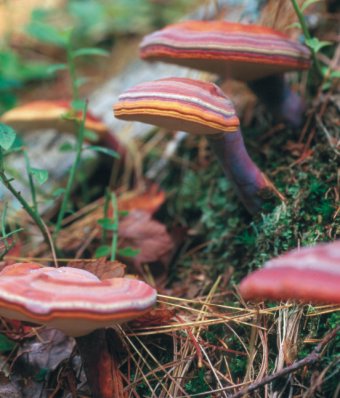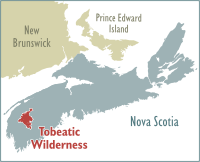
Saving the Tobeatic Wilderness, one inch at a time
By Andi Rierden
 |
| PHOTO: OLIVER MAASS Ganodermas mushrooms |
He handed White, whom he had never met, a government letter notifying the public that a core portion of wilderness called the Tobeatic was slated for logging. He asked if she would join a small group of residents to try to stop the plan and protect the lands.
The former schoolteacher, who had been active in politics for years and headed a local naturalists' club, had her doubts. “Don had this meek and mild presence,” White recalled. “I just didn't think it was in his bones to take on something like this. Little did I know.”
Within months, Rice, White, and other supporters, including foresters and a former Warden of Digby County, formed the Tobeatic Wilderness Committee with the sole focus of saving the largest wilderness area in the Maritimes. Thus began an uphill, and at times, tumultuous journey that involved educating dozens of politicians, agency heads and the public about the Tobeatic's importance and how human activities such as road building and resource extraction along sensitive corridors were undermining its ability to survive and support a diversity of plant and animal life.
Along the way, the committee became part of a growing grassroots coalition from Yarmouth to Cape Breton Island that continues to work with government agencies to try to change an age-old mindset of how the province views its natural lands. In large part the effort was the catalyst for the 1998 Wilderness Areas Protection Act, which has set aside 33 ecologically sensitive areas throughout the province and brought about more recent legislation that bans all-terrain vehicles from beaches, wetlands and designated wilderness areas.
Victories in stages
A major victory came last October when Mark Parent, minister of the Department of Environment and Labour, signed and released the Tobeatic Wilderness Area Management Plan based on recommendations from a 26-member advisory group that included representatives from the Tobeatic Wilderness Committee, fishing and hunting associations, municipalities and industry. The plan closed the chapter on two turbulent debates by prohibiting all-terrain and other motorized vehicles from entering the Tobeatic and initiating the phasing out of 32 campsite lease holdings.
Supporters throughout the province hailed the measure as a conservation milestone. “Because the Tobeatic remains virtually roadless, the management plan was the last opportunity for the province to conserve an area where ecosystems would be able to evolve with a bare minimum of human influence,” said David Dagley, the secretary of the Queen's County Fish & Game Association based in Liverpool, and a member of the advisory group.
The Tobeatic Wilderness Area is the largest of Nova Scotia's protected areas, spanning 104,131 hectares, or more than a quarter of a million acres. It is a mosaic of wetlands, barrens, meadows and dense woodland bordering five counties as well as Kejimkujik National Park. Isolated and unfragmented, this lush wilderness contains 11 distinct ecosystems from glacial plains to old-growth pine and hemlock forests. The province's small and endangered native moose population depends upon its undisturbed lands and waterways to survive, as do black bears, river otters, bobcats and the endangered Blanding's turtle and rare southern flying squirrel.
The landscape also beckons to Nova Scotia's cultural past. There are ancient Mi'kmaw sites, remnants of a British military road from 1784 and rangers' cabins dating back to 1927.
Detailing both the ecological and cultural values of the Tobeatic, the plan goes on to emphasize low-impact recreation, research and the preservation of the region's biodiversity. Leif Helmer, the regional coordinator for the Department of Environment and Labour's Protected Areas Branch, the division responsible for holding the public consultations and facilitating the advisory group, called the six-year process to develop the plan a complex ordeal.
“We learned very quickly that there were several different perceptions of the Tobeatic depending upon people's history and where they live,” he said. Helmer said a workshop to update the public on the implementation of the plan would be held near the Tobeatic this spring.
A 14-year effort
 |
 |
| PHOTO: ANDI RIERDEN Alice White and Don Rice. |
In early December, Alice White and Don Rice began sorting through the mountains of correspondence, committee newsletters, articles, editorials and miscellaneous materials dating back to 1993 when the committee was first formed.
“It shouldn't have taken 14 years to protect the Tobeatic, but at least it's done,” Rice said.
While the committee encountered its share of headaches, there were lighter moments, too, such as the time members drove to Halifax to meet Prince Philip, who was visiting Nova Scotia as the president emeritus of World Wildlife Fund. A number of conservation groups had been invited by the minister of natural resources to set up their displays. “He ended up staying at our table the longest, because we told him lots of jokes,” Rice said with a chuckle. “But he also said that Canada had lost so much of its wilderness since he and Elizabeth first started visiting in the 1950s.”
While most of the core members of the Tobeatic Wilderness Committee remain and new members have joined, a few have dropped out for philosophical reasons or plain exhaustion, he said.
“It's taken a toll on us personally, financially and career-wise,” Rice, a highly regarded potter, added. “A lot of the money to support this mission came off our kitchen tables.”
While the committee has earned several stewardship awards, its members also have been singled out and criticized in newspaper and magazine commentaries. Following the release of the management plan, one resident in a letter to the Halifax Chronicle Herald, called it “complete rubbish…” that caters to “elite wilderness campers and preservationists that want the area solely for their personal use.”
Rice said several committee members and most supporters have never set foot in the Tobeatic, including Alice White. “Here she's worked as hard as anyone to protect it and has never seen it.”
Said White: “I don't need to. I just have a love and respect for the natural world and a strong desire to protect it.”
As for the logging ordeal that sparked the idea for the Tobeatic Wilderness Committee, in 1997 the land in question was designated as part of the Tobeatic in exchange for 1,800 hectares [4,400 acres] of lands bordering the region in order for the province to fulfill a timber agreement with J.D. Irving Ltd. The next order of business, Rice said, is to persuade the government to bring those lands back into the Tobeatic and add other ecologically significant blocks of public land skirting its borders.
“We're talking about a lifetime of work,” Rice said.
See the Tobeatic Wilderness Area Management Plan, plus maps and other information on Nova Scotia's protected areas at: http://www.gov.ns.ca/enla/protectedareas.
Andi Rierden is a journalist and editor in Nova Scotia. She served as editor of the Gulf of Maine Times from 2000 to 2006.
© 2007 The Gulf of Maine Times